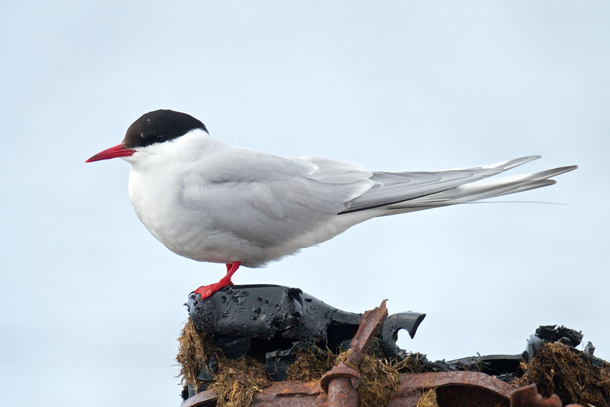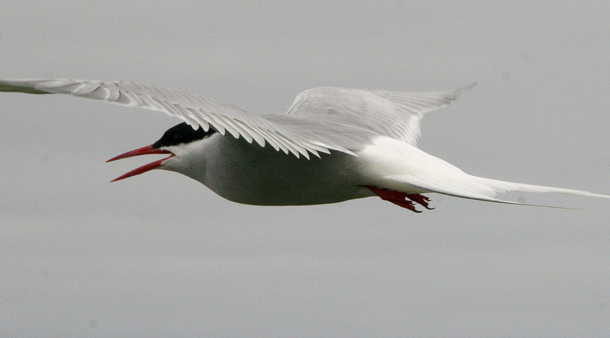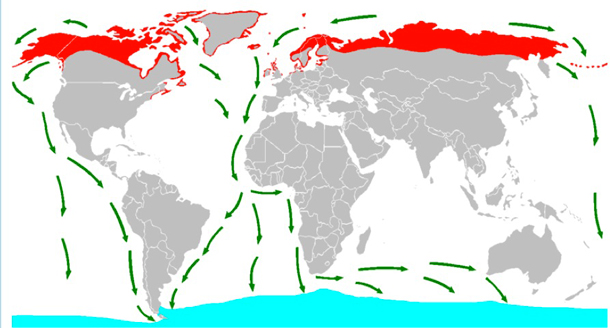BirdNote®: Rivers of Birds
Air Date: Week of April 5, 2019

Every year the Arctic Tern follows a migratory pattern of 50,000 miles, one of the longest routes for any bird. (Photo: Gregg Thompson)
Along the four major North American flyways, huge “rivers” of Arctic Terns and other migrating birds are now making their way north again. BirdNote®’s Mary McCann describes their incredible journey.
Transcript
[BIRDNOTE THEME]
CURWOOD: From the River of Grass we take you now to a river of birds with BirdNote’s Mary McCann.
[Sounds of migrating birds]
MCCANN: Imagine yourself in the stratosphere, looking down on North America. In spring and fall, you’ll see what look like huge “rivers” of ducks, seabirds, shorebirds, raptors, and songbirds. Migrants are moving along the four major North American flyways. In the spring, these “rivers” of birds flow north. At the end of the breeding season, the “rivers” flow south.

The Arctic Tern has the ability to spend most of its migration gliding rather than flapping its wings. (Photo: Joseph Slocum)
After spending the winter in the southern tier of states or Central America—or even as far away as South America—millions of birds return each spring to the northern latitudes. One of the world champions of long-distance migration is the Arctic Tern. [Calls of Arctic Terns]
Arctic Terns nest across the far northern reaches of the continent during our summer, then fly south to Antarctica for the rest of the year. Some will circle the polar ice-pack before heading north again, completing a total round trip of up to 50,000 miles. Every year. [Calls of Arctic Terns over the sound of ocean waves]

A map of the circumpolar migration that Arctic terns take. (Photo: Andreas Trepete))
###
Adapted from a script written by Frances Wood
Sounds of the migrating geese provided by Martyn Stewart at Naturesound.org.
Call of the Arctic Tern used with permission from Kevin Colver from the Field Guide to Bird Songs, Western Region.
BirdNote's theme music was composed and played by Nancy Rumbel and produced by John Kessler.
Producer: John Kessler
Executive Producer: Chris Peterson
© 2019 Tune In to Nature.org March 2019 Narrator: Mary McCann
CURWOOD: For pictures, swim on over to our website at loe.org.
Links
Living on Earth wants to hear from you!
Living on Earth
62 Calef Highway, Suite 212
Lee, NH 03861
Telephone: 617-287-4121
E-mail: comments@loe.org
Newsletter [Click here]
Donate to Living on Earth!
Living on Earth is an independent media program and relies entirely on contributions from listeners and institutions supporting public service. Please donate now to preserve an independent environmental voice.
NewsletterLiving on Earth offers a weekly delivery of the show's rundown to your mailbox. Sign up for our newsletter today!
 Sailors For The Sea: Be the change you want to sea.
Sailors For The Sea: Be the change you want to sea.
 The Grantham Foundation for the Protection of the Environment: Committed to protecting and improving the health of the global environment.
The Grantham Foundation for the Protection of the Environment: Committed to protecting and improving the health of the global environment.
 Contribute to Living on Earth and receive, as our gift to you, an archival print of one of Mark Seth Lender's extraordinary wildlife photographs. Follow the link to see Mark's current collection of photographs.
Contribute to Living on Earth and receive, as our gift to you, an archival print of one of Mark Seth Lender's extraordinary wildlife photographs. Follow the link to see Mark's current collection of photographs.
 Buy a signed copy of Mark Seth Lender's book Smeagull the Seagull & support Living on Earth
Buy a signed copy of Mark Seth Lender's book Smeagull the Seagull & support Living on Earth

